HOME >> CHINA
Dunhuang under new colors
Source:Global Times Published: 2013-9-24 19:03:01
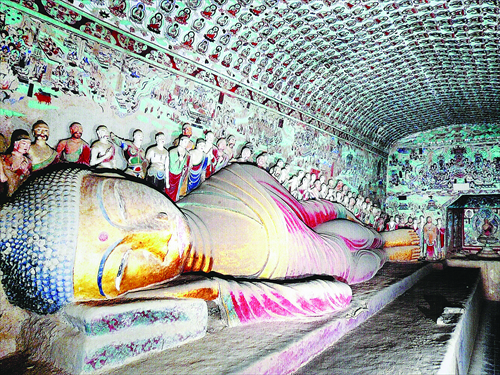
An inside view of a cave of the Mogao Grottoes in Dunhuang, Gansu Province Photo: IC
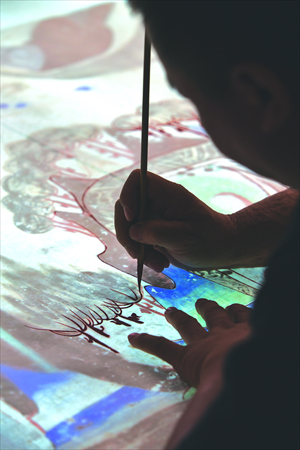
Hua Liang from the Art Institute of Dunhuang Academy touches up a painting. Photo: CFP
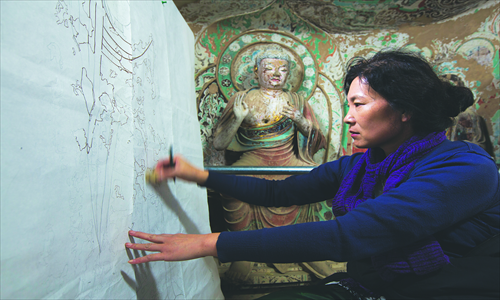
Guan Jinwen, who went to the institute in 1983, works on her copy in a cave of the Mogao Grottoes. Photo: CFP
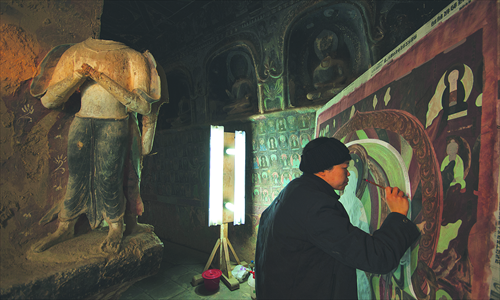
Painter Wu Shuangqin copies a wall painting in a cave of the Mogao Grottoes. Photo: CFP
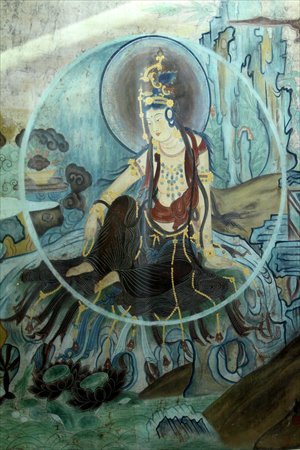
A copy of a wall painting from the Mogao Grottoes is displayed in Wuhan. Photo: CFP
While the ambitious plan to revive the Silk Road by building an economic belt hit recent media headlines, dozens of painters are working silently in the gloomy caves of the Mogao Grottoes in Dunhuang, Northwest China's Gansu Province, once a major stop along the ancient route.With brushes and mineral pigments, they copy wall paintings stroke by stroke, trying to preserve the Buddhist art made by their ancestors over a millennium dating back to AD 366.
Housing 45,000 square meters of murals and 2,415 painted sculptures, the 492 caves of the Mogao Grottoes were inscribed on the UNESCO World Heritage List in 1987.
Starting in 1941, Chinese artists, including Zhang Daqian and Chang Shuhong, moved to Dunhuang with their families and spent years copying and preserving the spectacular relics.
"Such copies can help the paintings endure and display this unmovable art to more people," Wang Xudong, director general of Dunhuang Academy, told the Global Times. The academy, established in 1944, is dedicated to safeguarding the relics in Dunhuang.
Copying the paintings in the caves is an arduous job. From using torches and candles, to kerosene lamps and flashlights, to now fluorescent light, several generations of artists have devoted themselves to this cause.
"Nevertheless, less than 20 caves have been fully copied so far," Wang said, adding that about 40 painters now are working full-time on this Herculean task.
Today the painters can finish their first draft by using images in art studios. But they still need to spend lots of time in the caves to finish off every detail in terms of colors and strokes.
"I thought we did a good job in protecting the grottoes. But when comparing the earliest photos taken in 1908 with images taken today, we find that the artworks today are much more blurred. The relics are deteriorating," Fan Jinshi, president of the Dunhuang Academy, said in a documentary film.
"The daily visitors exceed 6,000 to 7,000 nowadays. But it would be reasonable to restrict this number to 3,000," Fan told the Guangming Daily in August.
People's activities will affect the environment and directly threaten the lifespan of the cultural relics. To limit these side effects to a minimum, people are only allowed to visit under 10 caves each time and each tour is limited to two hours. These restrictions have met with complaints from many tourists.
To counter this, a digital museum offering 3D virtual views of the grottoes is being built near the site. The Dunhuang Mogao Grottoes Visitor Center, which started construction in 2010 with an investment of 300 million yuan ($49 million), is set to open in May 2014.
"However, digital recordings can never replace manual copies. The relics carry the beliefs, culture and techniques of the ancient painters and artisans. Only by being there can the current artists truly feel and understand them," Wang noted.
Global Times
Posted in: In-Depth